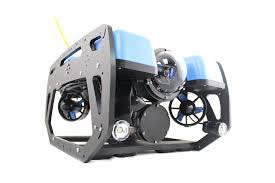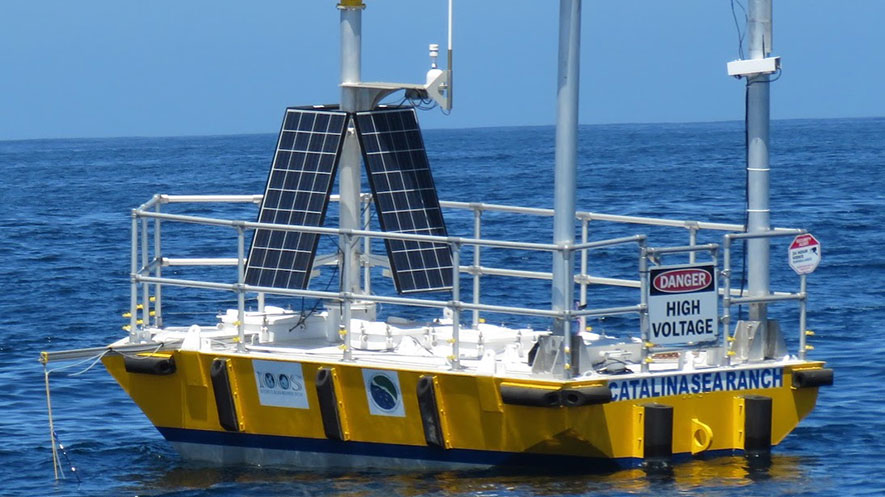Imagine taking the pulse of a remote area of the ocean in real time to understand trends, anticipate problems, and devise mitigation measures for immediate corrective actions. Imagine if ocean technology pioneers had a platform to rapidly prove new marine technologies in the field. Six miles off the coast of Southern California, Catalina Sea Ranch is doing exactly that.
Catalina Sea Ranch, the developer of the first offshore aquaculture facility in United States Federally regulated waters, has developed a 4G LTE internet connected NOMAD buoy to enable remote, real-time monitoring of the sea surrounding their operations. This innovative Ocean Internet of Things™ platform provides access to all collected data, which is transmitted to the cloud in real time. An open hardware architecture and open-source software background makes it easy to integrate and test a wide variety of sensors and equipment. NOAA graciously provided the NOMAD for use in this capacity.
Onsite testing of the NOMAD began in July 2016 with wireless data collection and transmission to the internet via the Verizon cellular network. In its initial configuration, the NOMAD has sensors for ocean temperature, salinity, dissolved oxygen, for monitoring ecosystem health and a camera that frequently transmits a live picture of the buoy and its surroundings.
Dr. Kristen Davis of University of California, Irvine provided a Seabird MicroCAT sensor for establishing a site baseline. A VEMCO VR2C Acoustic Monitoring Receiver was provided by the Ocean Tracking Network so that Dr. Chris Lowe’s Shark Lab at California State University Long Beach can identify nearby sharks that have been tagged with acoustic transmitters.
Atmospheric data including wind direction, speed, temperature, and humidity is being transmitted by a MOTE meteorological station as part of a collaboration with Dr. Jason Hallstrom of Florida Atlantic University. Coastal Carolina University provided an Acoustic Doppler Current Profiler (ADCP) to monitor ocean currents and ultimately wave conditions to provide a baseline of physical forcings and variability at the site. CCU intends to employ a fully interactively coupled ocean-atmosphere-wave model system to help characterize the site and project developing conditions into the future.
This monitoring capability will benefit more than just aquaculture - it will be used as a platform to test and validate technologies for use in the maritime industry, from environmental corrosion to the impact of equipment on marine life. This knowledge is critical for other efforts, such as the development of marine hydrokinetic energy sites in coastal ocean waters. The NOMAD’s testing capabilities will allow for rapid technology transition from the lab to the field. It will provide conditions conducive to early-stage technologies with constant monitoring, power, and on-location connectivity. Technologies identified for near-term testing in conjunction with the NOMAD include oceanographic sensors, subsea vehicles and equipment, acoustic systems for communication, marine mammal tracking, and robotic automation systems.
 Catalina Sea Ranch is working closely with another Southern California company, Blue Robotics, to test marine equipment from the buoy, including sensors and its new product, the BlueROV2 vehicle. “When working on new technology, testing is critical,” says Rustom Jehangir of Blue Robotics. According to him, the NOMAD “has already provided us with a number of opportunities to test our sensor and vehicle systems in the harsh ocean environment.” There are plans to eventually have a vehicle permanently installed on the Nomad for remote inspection work.
Catalina Sea Ranch is working closely with another Southern California company, Blue Robotics, to test marine equipment from the buoy, including sensors and its new product, the BlueROV2 vehicle. “When working on new technology, testing is critical,” says Rustom Jehangir of Blue Robotics. According to him, the NOMAD “has already provided us with a number of opportunities to test our sensor and vehicle systems in the harsh ocean environment.” There are plans to eventually have a vehicle permanently installed on the Nomad for remote inspection work.
Phil Cruver, CEO of Catalina Sea Ranch, stated that, “real time analysis of data collected by the NOMAD will create models to help optimize our aquaculture facility’s productivity and to minimize any environmental impact.” He continued to say that this capacity “will provide solid scientific data that will eventually lead to sound regulations for advancing offshore aquaculture.”
Catalina Sea Ranch worked in conjunction with engineer, Tony White, to develop the hardware infrastructure and with Rustom Jehangir of Blue Robotics to develop the software architecture of the NOMAD. The software developed for the project is open-source and freely available in an effort to foster dynamic growth with additional participants. For more information, see the NOMAD live data website here.
By: Phil Cruver, Catalina Sea Ranch LLC, Tony White, Consulting Engineer and Rustom Jehangir, Blue Robotics





